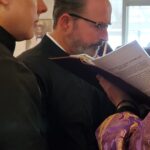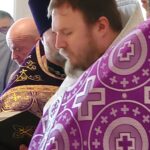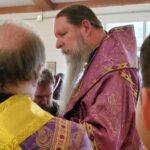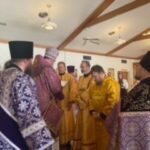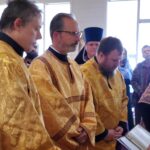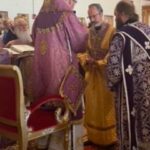On Sat. March 19, 2022 at the hierarchical Divine Liturgy celebrated by his eminence, Archbishop Kyrill of San Francisco and Western America two parishioners of St. Nicholas Church advanced to ordination to minor Holy Orders.
- Michael Alvey was ordained a Reader.
- Michael Winters was also ordained a Reader, then immediately ordained a Subdeacon.
More photos to be posted when we get them.
These orders are ancient within the Church and go back to at least the second century, and are mentioned by St. Hippolytus of Rome in his work, the Apostolic Tradition, including the prayers for ordination.
Reader
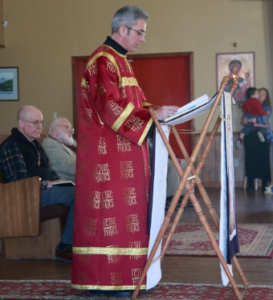 A Reader, also called a Lector, Cantor, or Psalti, the Reader is the first order comprising participation in the Priesthood of Christ. It is a sub-clerical order to which a man is tonsured and ordained, setting him apart as blessed by the bishop to read in services and in the Divine Liturgy.
A Reader, also called a Lector, Cantor, or Psalti, the Reader is the first order comprising participation in the Priesthood of Christ. It is a sub-clerical order to which a man is tonsured and ordained, setting him apart as blessed by the bishop to read in services and in the Divine Liturgy.
Immediately before ordination as a reader, the candidate is tonsured as a sign of his submission and obedience upon entry into the clerical state. This is a separate act, making a layperson into a clergyman, and occurs immediately prior to his ordination as a reader.
After being tonsured, the reader is vested in a short phelonion, which he wears while reading the Epistle for the first time. This short phelon is then removed (and never worn thereafter) and replaced with a sticharion, which the reader generally wears thereafter whenever he performs his liturgical duties. All degrees of clergy wear the sticharion.
Subdeacon
 The reader who is to be ordained subdeacon is presented to the bishop, usually by two other subdeacons, he faces east and makes a prostration before turning to make three prostrations towards the bishop, moving further west after each one. He is then led to stand immediately before the bishop. The orarion is presented to the bishop, who blesses it. The ordinand then kisses the orarion and the bishop’s hand, and the subdeacons vest the new subdeacon in the orarion.
The reader who is to be ordained subdeacon is presented to the bishop, usually by two other subdeacons, he faces east and makes a prostration before turning to make three prostrations towards the bishop, moving further west after each one. He is then led to stand immediately before the bishop. The orarion is presented to the bishop, who blesses it. The ordinand then kisses the orarion and the bishop’s hand, and the subdeacons vest the new subdeacon in the orarion.
The orarion represents the grace of the Holy Spirit. The orarion will be tied around his waist, up over his shoulders (forming an X-shaped cross in back), and with the ends hanging down in front, tucked under the section around the waist in an X-shaped cross.
The ordination of readers and subdeacons, is done through Cheirothesia – literally, “to place hands” – as opposed to Cheirotonia – “to stretch out the hands” – which is practiced at the ordination of those in major orders (bishops, priests and deacons). It is through ordination – not the tonsure – that one is made a reader or subdeacon; this is highlighted by the fact that the tonsure is performed only once and is not repeated before the ordination of a subdeacon.
